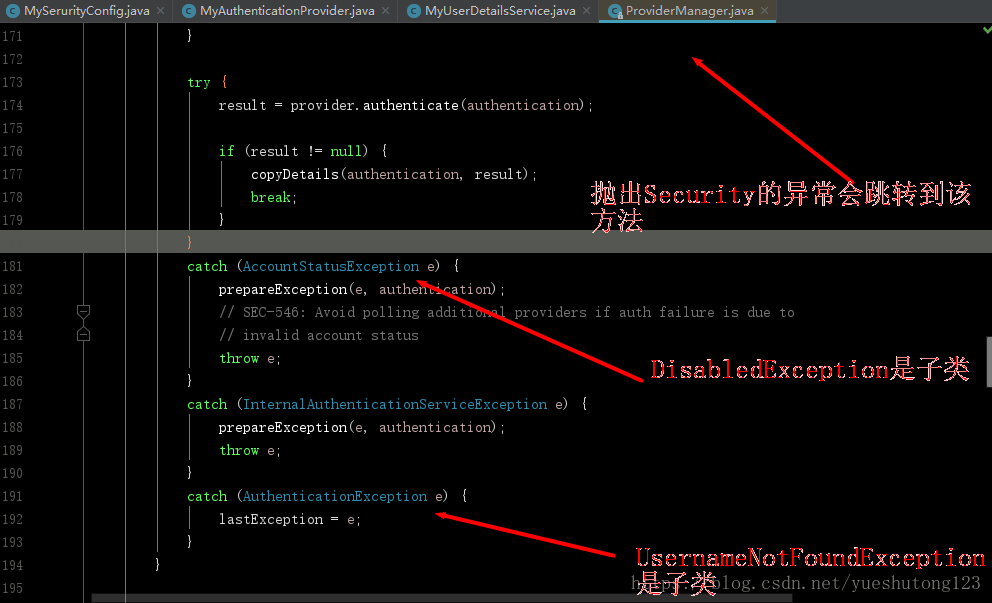从源码看Spring Security之采坑笔记(Spring Boot篇)
一:唠嗑
- 鼓捣了两天的Spring Security,踩了不少坑。如果你在学Spring Security,恰好又是使用的Spring Boot,那么给我点个赞吧!这篇博客将会让你了解Spring Security的各种坑!
- 阅读前说一下,这篇博客是我一字一字打出来的,转载务必注明出处哦!
- 另外,本文已授权微信公众号“后端技术精选”独家发布
二:开始
1.准备
- Spring boot 1.5
- Mysql 5.7
- 导入依赖
<!-- Web工程 --><dependency><groupId>org.springframework.boot</groupId><artifactId>spring-boot-starter-web</artifactId></dependency><!-- 数据库相关 --><dependency><groupId>org.springframework.boot</groupId><artifactId>spring-boot-starter-data-jpa</artifactId></dependency><dependency><groupId>mysql</groupId><artifactId>mysql-connector-java</artifactId></dependency><!-- security 核心 --><dependency><groupId>org.springframework.boot</groupId><artifactId>spring-boot-starter-security</artifactId></dependency><!-- thymeleaf 模板--><dependency><groupId>org.springframework.boot</groupId><artifactId>spring-boot-starter-thymeleaf</artifactId></dependency><!-- 可以在HTML使用sec标签操作Security --><dependency><groupId>org.thymeleaf.extras</groupId><artifactId>thymeleaf-extras-springsecurity4</artifactId></dependency>
2.开启Security并配置
package cn.zyzpp.security.config;import org.springframework.beans.factory.annotation.Autowired;import org.springframework.context.annotation.Configuration;import org.springframework.security.authentication.AuthenticationProvider;import org.springframework.security.config.annotation.authentication.builders.AuthenticationManagerBuilder;import org.springframework.security.config.annotation.web.builders.HttpSecurity;import org.springframework.security.config.annotation.web.builders.WebSecurity;import org.springframework.security.config.annotation.web.configuration.EnableWebSecurity;import org.springframework.security.config.annotation.web.configuration.WebSecurityConfigurerAdapter;import org.springframework.security.core.userdetails.UserDetailsService;/*** Create by yster@foxmail.com 2018/6/10/010 18:07*/@EnableWebSecuritypublic class MySerurityConfig extends WebSecurityConfigurerAdapter {/*自己实现下面两个接口*/@Autowiredprivate AuthenticationProvider authenticationProvider;@Autowiredprivate UserDetailsService userDetailsService;@Overrideprotected void configure(HttpSecurity http) throws Exception {http.authorizeRequests().antMatchers("/", "/signIn").permitAll()//所有人都可以访问.antMatchers("/leve/1").hasRole("VIP1") //设置访问角色.antMatchers("/leve/2").hasRole("VIP2").antMatchers("/leve/3").hasAuthority("VIP2")//设置访问权限.anyRequest().authenticated() //其他所有资源都需要认证,登陆后访问.and().formLogin()//开启自动配置的授权功能.loginPage("/login") //自定义登录页(controller层需要声明).usernameParameter("username") //自定义用户名name值.passwordParameter("password") //自定义密码name值.failureUrl("/login?error") //登录失败则重定向到此URl.permitAll() //登录页都可以访问.and().logout()//开启自动配置的注销功能.logoutSuccessUrl("/")//注销成功后返回到页面并清空Session.and().rememberMe().rememberMeParameter("remember")//自定义rememberMe的name值,默认remember-Me.tokenValiditySeconds(604800);//记住我的时间/秒}/*定义认证规则*/@Overrideprotected void configure(AuthenticationManagerBuilder auth) throws Exception {/* 保存用户信息到内存中auth.inMemoryAuthentication().withUser("张三").password("123456").roles("VIP1").and().withUser("李四").password("123456").roles("VIP2");*//*自定义认证*/auth.authenticationProvider(authenticationProvider);auth.userDetailsService(userDetailsService);//不定义的话rememberMe报错}/*忽略静态资源*/@Overridepublic void configure(WebSecurity web) {web.ignoring().antMatchers("/resources/static/**");}}
讲一下:
- 我们基本不会把用户信息保存在内存中,所以我们自定义认证方法。这里我推荐阅读 认证(Authentication)与源码解读 了解。
- 自定义认证也有两种方法,第一是注入DaoAuthenticationProvider(org.springframework.security.authentication.dao)
@Beanpublic DaoAuthenticationProvider daoAuthenticationProvider(){DaoAuthenticationProvider daoAuthenticationProvider = new DaoAuthenticationProvider();daoAuthenticationProvider.setUserDetailsService(userDetailsService);//获取用户信息daoAuthenticationProvider.setPasswordEncoder(new Md5PasswordEncoder());//MD5加密daoAuthenticationProvider.setSaltSource(new SaltSource() { //加盐@Overridepublic Object getSalt(UserDetails user) {return user.getUsername();}});return daoAuthenticationProvider;}
- 然后改一下设置
auth.authenticationProvider(authenticationProvider);
这种方法我并不推荐,因为我们把密码错误的异常交给了Security底层去抛出,然而抛出的消息只是
Bad credentials这样的消息提示你会需要?所以我们使用第二种方法,如下:
3.自定义AuthenticationProvider接口实现类
package cn.zyzpp.security.config;import org.springframework.beans.factory.annotation.Autowired;import org.springframework.security.authentication.AuthenticationProvider;import org.springframework.security.authentication.DisabledException;import org.springframework.security.authentication.UsernamePasswordAuthenticationToken;import org.springframework.security.authentication.encoding.Md5PasswordEncoder;import org.springframework.security.core.Authentication;import org.springframework.security.core.userdetails.UserDetails;import org.springframework.stereotype.Component;/*** Create by yster@foxmail.com 2018/6/21/021 15:53* Authentication 是一个接口,用来表示用户认证信息的*/@Componentpublic class MyAuthenticationProvider implements AuthenticationProvider{@Autowiredprivate MyUserDetailsService userDetailsService;@Overridepublic Authentication authenticate(Authentication authentication){//1.获取用户输入的用户名 密码String username = authentication.getName();String password = (String) authentication.getCredentials();//2.关于MD5加密://因为我们是自定义Authentication,所以必须手动加密加盐而不需要再配置。password = new Md5PasswordEncoder().encodePassword(password,username);//3.由输入的用户名查找该用户信息,内部抛出异常UserDetails user = userDetailsService.loadUserByUsername(username);//4.密码校验if (!password.equals(user.getPassword())) {throw new DisabledException("---->UserName :" + username + " password error!");}return new UsernamePasswordAuthenticationToken(user, password, user.getAuthorities());}@Overridepublic boolean supports(Class<?> aClass) {return (UsernamePasswordAuthenticationToken.class.isAssignableFrom(aClass));}}
讲一下:
- 这里说Security的一个坑:
相信你也看到了有的教程上说抛出
UsernameNotFoundException用户找不到,BadCredentialsException坏的凭据,但这两个类都是继承自AuthenticationException抽象类,当你抛出这俩异常时,Security底层会捕捉到你抛出的异常,如图:
看到了吧,
AuthenticationException异常并不会被抛出,debug调式一下,你就会感受到它的曲折历程,相当感人!然后莫名其妙的被换掉了,而且无解。- 没错,你没看错,
AccountStatusException异常被直接抛出了,这正是我们需要的;有的同学可能想到了自定义异常,但我们是结合Security框架,要按人家的规则来,不信你试试。 - 附一些常用异常
/*AuthenticationException常用的的子类:(会被底层换掉,不推荐使用)UsernameNotFoundException 用户找不到BadCredentialsException 坏的凭据AccountStatusException用户状态异常它包含如下子类:(推荐使用)AccountExpiredException 账户过期LockedException 账户锁定DisabledException 账户不可用CredentialsExpiredException 证书过期*/
4.自定义UserDetailsService接口实现类
package cn.zyzpp.security.config;import cn.zyzpp.security.entity.Role;import cn.zyzpp.security.service.UserService;import org.springframework.beans.factory.annotation.Autowired;import org.springframework.security.authentication.DisabledException;import org.springframework.security.core.GrantedAuthority;import org.springframework.security.core.authority.SimpleGrantedAuthority;import org.springframework.security.core.userdetails.User;import org.springframework.security.core.userdetails.UserDetails;import org.springframework.security.core.userdetails.UserDetailsService;import org.springframework.stereotype.Component;import java.util.ArrayList;import java.util.List;/*** 进行认证的时候需要一个 UserDetailsService 来获取用户的信息 UserDetails,* 其中包括用户名、密码和所拥有的权限等。* Create by yster@foxmail.com 2018/6/21/021 15:56*/@Componentpublic class MyUserDetailsService implements UserDetailsService {@Autowiredprivate UserService userService;/** 采坑笔记:* new SimpleGrantedAuthority("...")时* 加前戳是Role,通过hasRole()获取,用来认证角色;* 不加前戳是Authoritiy,通过hasAuthority()获取,用来鉴定权限;* 总结:加前戳是角色,不加前戳是权限。此前戳只用于本类。*/String role_ = "ROLE_";@Overridepublic UserDetails loadUserByUsername(String username) {//1.业务层根据username获取该用户cn.zyzpp.security.entity.User user = userService.findUserByUserName(username);if (user == null) {//这里我们不抛出UsernameNotFoundException因为Security会把我们抛出的该异常捕捉并换掉;//这里要明确Security抛出的异常无法被ControllerAdvice捕捉到,无法进行统一异常处理;//而我们只需要打印正确的异常消息即可,Security自动把异常添加到HttpServletRequest或HttpSession中throw new DisabledException("---->UserName :" + username + " not found!");}//2.从业务层获取用户权限并转为AuthoritiesList<GrantedAuthority> authorities = new ArrayList<>();for (Role role : user.getRoleList()) {authorities.add(new SimpleGrantedAuthority(role.getName()));//设置权限authorities.add(new SimpleGrantedAuthority(role_ + role.getName()));//设置角色}//3.返回Spring定义的User对象return new User(username, user.getPassword(), authorities);}}
讲一下:
- 我们在保存用户信息到内存中时是这样的
auth.inMemoryAuthentication().withUser("张三").password("123456").roles("ROLE_VIP1").authorities("VIP1")
- 角色和权限是分开设置的,但我们在自定义时只有权限设置,
authorities.add(new SimpleGrantedAuthority("权限名"));
- 定义以后你会发现这真真真…的是权限,不是角色,联想到上面Security的角色和权限其实是不同的,我想我应该是错过了什么?
然后翻看Security源码:
翻译过来:如果调用hasRole(“ADMIN”)或hasRole(“ROLE_ADMIN”)
方法时,当Role前缀为”ROLE_”(默认)时将使用ROLE_ADMIN角色。而我们在把用户信息保存到内存时,底层是这样的:
解读一下就是在调用
.roles("ROLE_VIP1")方法注册Role时,先通过role.startsWith("ROLE_")断言输入的角色名是否是"ROLE_"开头的,如果不是,补充"RELE_"前戳。- 所以,Security解决角色和权限分开的依据就是是否含有
"ROLE_"前戳,该默认前戳也是可以自己修改的。 - ok,继续我们的Security学习之路。
5.获取Security登录异常信息
package cn.zyzpp.security.controller;...import cn.zyzpp.security.service.UserService;import javax.servlet.http.HttpServletRequest;import javax.servlet.http.HttpSession;/*** Create by yster@foxmail.com 2018/6/10/010 18:35*/@Controllerpublic class MyController {@AutowiredUserService userService;@AutowiredHttpSession session;@AutowiredHttpServletRequest request;/*ModelMap的Key*/final String ERROR = "error";/*** 自定义登录页并进行异常信息提示* 需要在Security中设置*/@RequestMapping(value = "/login")public String login(ModelMap modelMap){/*security的AuthenticationException异常自动保存在request或session中官方默认保存在Session,但我们自定义过多。我测试是在request中。所以在html页面还需要搭配th:if="${param.error!=null}"检查Url是否有参数error*/String key = WebAttributes.AUTHENTICATION_EXCEPTION;if (session.getAttribute(key)!=null){// System.out.println("request");AuthenticationException exception = (AuthenticationException) session.getAttribute(key);modelMap.addAttribute(ERROR,exception.getMessage());}if (request.getAttribute(key)!=null){// System.out.println("session");AuthenticationException exception = (AuthenticationException) request.getAttribute(key);modelMap.addAttribute(ERROR,exception.getMessage());}return "login";}}
自定义login登录页面
- Security规定若是GET访问则是请求页面,POST访问则为提交登录
<!DOCTYPE html><html xmlns:th="http://www.thymeleaf.org"><head><meta charset="UTF-8"/><title>登录页面</title></head><body><form th:action="@{/login}" method="post">用户名:<input type="text" placeholder="username" name="username" required=""/><br/>密码:<input type="password" placeholder="password" name="password" required=""/><br/>记住我:<input type="checkbox" name="remember"/><input type="submit" value="提交"/><span th:if="${param.error!=null}" th:text="${error}"/></form></body></html>
讲一下:
- 如果你debug追踪一下,你就可以了解Security的运行原理
- Security的
SimpleUrlAuthenticationFailureHandler(简单认证故障处理)会把异常保存到request或session中,forwardToDestination默认为false,也就是保存在session,实际我们测试是保存在request。
6.在view层使用Security
6.1 使用HTML sec标签 (推荐)
<!DOCTYPE html><html xmlns:th="http://www.thymeleaf.org" xmlns:sec="http://www.thymeleaf.org/thymeleaf-extras-springsecurity4"><head><meta charset="UTF-8"/><title>首页</title></head><body><div sec:authorize="isAuthenticated()"><form th:action="@{/logout}" method="POST"><input type="submit" value="注销" /></form>user:<b sec:authentication="name"></b><br/><!-- principal对应org.springframework.security.core.userdetails.User类 -->Role:<b sec:authentication="principal.authorities"></b></div><div sec:authorize="!isAuthenticated()"><h2>游客你好!</h2>请<a th:href="@{/login}">登录</a></div><div sec:authorize="hasRole('VIP1')"><h2>ROLE_VIP1_可见</h2></div><div sec:authorize="hasRole('VIP2')"><h2>ROLE_VIP2_可见</h2></div><div sec:authorize="hasAuthority('VIP1')"><h2>Authority:VIP1_可见</h2></div></body></html>
6.2 编码获取用户登录信息
- 下面为我自己写的方法,看看就好!
/*** 不使用sec标签(不推荐)* 在Controller获取用户信息*/@RequestMapping("/index")public String index1(ModelMap model){userAndRoles(model);return "index";}/*** Security辅助方法:获取用户信息*/private void userAndRoles(ModelMap model) {//从Security获取当前用户会话Object principal = SecurityContextHolder.getContext().getAuthentication().getPrincipal();User user = null;//判断用户已经登录if (principal instanceof User){user = (User) principal;//遍历迭代器获取用户权限Iterator<GrantedAuthority> iterator = user.getAuthorities().iterator();List<String> roles = new ArrayList<>();while (iterator.hasNext()){roles.add(iterator.next().getAuthority());}//保存角色信息model.addAttribute("roles",roles.toString());}//保存用户信息,未登录为空model.addAttribute("user",user);}
6.权限及用户的Entity类
- 权限表
/*** 权限表* Create by yster@foxmail.com 2018/6/21/021 18:00*/@Entity@Table(name = "role")public class Role {@Id@GeneratedValueprivate int id;private String name;...}
- 用户表
/*** Create by yster@foxmail.com 2018/6/21/021 17:59*/@Entity@Table(name = "user",uniqueConstraints = {@UniqueConstraint(columnNames="username")})public class User {@Id@GeneratedValueprivate int id;private String username;private String password;@OneToMany(cascade={CascadeType.ALL}, fetch=FetchType.EAGER)@JoinColumn(name = "r_id")private List<Role> roleList;....}
- 关于Security的部分先到这里,之所以写这篇博客,源于网上的相关资料略少,坑略多,毕竟做伸手党做惯了,一些坑踩的还是不容易的!
- 项目我已经打包上传至:https://download.csdn.net/download/yueshutong123/10494694
2019/1/9补充
Spring Security在方法级别上的保护
Spring Security从2.0版本开始,提供了方法级别的安全支持,并提供了 JSR-250 的支持。写一个配置类 SecurityConfig 继承 WebSecurityConfigurationAdapter,并加上相关注解,就可以开启方法级别的保护。
@EnableWebSecurity@Configuration@EnableGlobalMethodSecurity(prePostEnabled = true)public class SerurityConfig extends WebSecurityConfigurerAdapter {}
在上面的配置代码中,@EnableGlobalMethodSecurity(prePostEnabled = true) 注解开启了方法级别的保护,括号后面的参数可选,可选的参数如下。
- prePostEnabled:Spring Security 的 Pre 和 Post 注解是否可用,即 @PreAuthorize 和 @PostAuthorize 是否可用。
- secureEnabled:Spring Security 的 @Service 注解是否可用。
- jsr250Enabled:Spring Security 对 JSR-250 的注解是否可用。
一般来说,只会用到 prePostEnabled。因为 即 @PreAuthorize 注解比 @PostAuthorize 注解更适合方法级别的安全控制,并且支持 Spring EL 表达式,适合 Spring 开发者。其中,@PreAuthorize 注解会在进入方法钱进行权限验证,@PostAuthorize 注解在方法执行后再进行权限验证。
如何在方法上写权限注解呢?
例如有权限点字符串“ROLE_ADMIN”,在方法上可以写为 @PreAuthorize(“hasRole(‘ADMIN’)”),也可以写为 @PreAuthorize(“hasAuthority(‘ROLE_ADMIN’)”),这二者是等价的。加多个权限点,可以写为 @PreAuthorize(“hasRole(‘ADMIN’,‘USER’)”)、@PreAuthorize(“hasAuthority(‘ROLE_ADMIN’,‘ROLE_USER’)”)。
从源码看Spring Security之采坑笔记(Spring Boot篇)的更多相关文章
- clickhouse源码Redhat系列机单机版安装踩坑笔记
前情概要 由于工作需要用到clickhouse, 这里暂不介绍概念,应用场景,谷歌,百度一大把. 将安装过程踩下的坑记录下来备用 ClickHouse源码 git clone安装(直接下载源码包安装失 ...
- 解密随机数生成器(二)——从java源码看线性同余算法
Random Java中的Random类生成的是伪随机数,使用的是48-bit的种子,然后调用一个linear congruential formula线性同余方程(Donald Knuth的编程艺术 ...
- spring源码解析(一) 环境搭建(各种坑的解决办法)
上次搭建spring源码的环境还是两年前,依稀记得那时候也是一顿折腾,奈何当时没有记录,导致两年后的今天把坑重踩了一遍,还遇到了新的坑,真是欲哭无泪;为了以后类似的事情不再发生,这次写下这篇博文来必坑 ...
- 从源码看Azkaban作业流下发过程
上一篇零散地罗列了看源码时记录的一些类的信息,这篇完整介绍一个作业流在Azkaban中的执行过程,希望可以帮助刚刚接手Azkaban相关工作的开发.测试. 一.Azkaban简介 Azkaban作为开 ...
- 从源码看Android中sqlite是怎么通过cursorwindow读DB的
更多内容在这里查看 https://ahangchen.gitbooks.io/windy-afternoon/content/ 执行query 执行SQLiteDatabase类中query系列函数 ...
- 从源码看Android中sqlite是怎么读DB的(转)
执行query 执行SQLiteDatabase类中query系列函数时,只会构造查询信息,不会执行查询. (query的源码追踪路径) 执行move(里面的fillwindow是真正打开文件句柄并分 ...
- 从Chrome源码看浏览器的事件机制
.aligncenter { clear: both; display: block; margin-left: auto; margin-right: auto } .crayon-line spa ...
- 从Chrome源码看JS Array的实现
.aligncenter { clear: both; display: block; margin-left: auto; margin-right: auto } .crayon-line spa ...
- 从源码看JDK提供的线程池(ThreadPoolExecutor)
一丶什么是线程池 (1)博主在听到线程池三个字的时候第一个想法就是数据库连接池,回忆一下,我们在学JavaWeb的时候怎么理解数据库连接池的,数据库创建连接和关闭连接是一个比较耗费资源的事情,对于那些 ...
随机推荐
- 官网下载的Struts 2解压后缺少xwork-core.jar文件
为Eclipse配置Struts-2.5.10所需最少jar文件: 缺少的文件已被合并在struts2-core-2.5.10.jar文件中.我下的是最新版的,如果你下的找不到就是这个原因啦.
- 关于bug的一些思考
上午看了两道算法,自己编译器上面敲了一遍,然后又去网站上敲了一遍: 编译器上面无论哦如何都调不出来,网站上面也是: 吃个午饭,睡个觉,醒来重新手撸了一遍,然后就过了 : 面对这种事情,真的是自己应该多 ...
- Spark SQL整体架构
0.整体架构 注意:Spark SQL是Spark Core之上的一个模块,所有SQL操作最终都通过Catalyst翻译成类似的Spark程序代码被Spark Core调度执行,其过程也有Job.St ...
- jar、war、ear
附加jboss里面的application.xml <?xml version=”1.0″ encoding=”UTF-8″?> <application xmlns="h ...
- C#核心基础--类的声明
C#核心基础--类的声明 类是使用关键字 class 声明的,如下面的示例所示: 访问修饰符 class 类名 { //类成员: // Methods, properties, fields, eve ...
- postgresql自定义类型并返回数组
转自 https://blog.csdn.net/victor_ww/article/details/44415895 create type custom_data_type as ( id int ...
- 在泛微系统中修改AD密码的配置
参照文档: Windows server 2008 R2 安装AD域证书:https://blog.csdn.net/zhuyongru/article/details/81107839 配置泛微OA ...
- c/c++ 重载运算符的思考
c/c++ 重载运算符的思考 #include <iostream> using namespace std; class Imaginary{ public: Imaginary():r ...
- 02.Python网络爬虫第二弹《http和https协议》
一.HTTP协议 1.官方概念: HTTP协议是Hyper Text Transfer Protocol(超文本传输协议)的缩写,是用于从万维网(WWW:World Wide Web )服务器传输超文 ...
- 关于this的理解
var o = { a:10, b:{ a:12, fn:function(){ console.log(this.a); //undefined console.log(this); //windo ...




